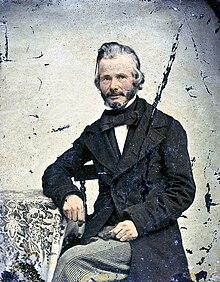John Stringfellow
John Stringfellow | |
|---|---|
 20th century tin-plate photograph | |
| Born | 1799 |
| Died | 13 December 1883 (aged 84) Chard, Somerset, England |
| Known for | Aerial Steam Carriage |
| Spouse(s) | Hannah Ketch (m. 1827) |
| Children | 6 sons, 4 daughters |
John Stringfellow (1799 – 13 December 1883) was a British early aeronautical inventor, known for his work on the Aerial Steam Carriage[1] with William Samuel Henson.
Life[]

Stringfellow was born in Attercliffe, England and in 1820 moved to Chard, Somerset, England to work as a maker of bobbins and carriages for the lace industry. On 27 February 1827 he married Hannah Ketch, and together they had 10 children.[2]
Together with William Samuel Henson, he had ambitions of creating an international company, the Aerial Transit Company, with designs showing aeroplane travel in exotic locations like Egypt and China. Despite their efforts, the designs were flawed with Stringfellow's ideas centred on monoplane and triplane models and Henson's ideas centred on an underpowered steam-powered vehicle. In 1848 Stringfellow achieved the first powered flight using an unmanned 10 ft wingspan steam-powered monoplane built in a disused lace factory in Chard, Somerset. Employing two contra-rotating propellers on the first attempt, made indoors, the machine flew ten feet before becoming destabilised, damaging the craft. The second attempt was more successful, the machine leaving a guide wire to fly freely, achieving some thirty yards of straight and level powered flight.[3][4][5] Stringfellow was also a keen photographer in his spare time, having run his father's photography business in Chard, of which Stringfellow was one of the first to produce a wet print of an image in his studios. The studio in Chard, and his home in Crewkerne is where some of his flying machines were photographed.
A bronze model of that first primitive aircraft stands in Fore Street in Chard. The town's museum has a unique exhibition of flight before the advent of the internal combustion engine and before the manned, powered flight made famous by the Wright Brothers. Stringfellow also invented and patented compact electric batteries, which were used in early medical treatment. Stringfellow's work was featured in an exhibition in 1868 at The Crystal Palace in London.
Stringfellow's first powered flight achievement was referenced in the 1965 movie The Flight of the Phoenix. The character Heinrich Dorfmann (Hardy Krüger), a German airplane designer, explains that it was a model airplane that made the first powered flight in 1851 and that though his own experience with airplane design is with building models, the principles are the same. His design for an airplane to be built from the scraps of their crashed plane will fly them out of the desert to safety.
Stringfellow and Henson are honoured by the Royal Aeronautical Society with an annual lecture and dinner in Yeovil[6][circular reference]
In light of recent research and developments at historical archives, a number of history and textbooks which present the view that the Wright Brothers invented powered flight are having to be changed and replaced by the 'true' inventor, John Stringfellow of Chard, and finally get the recognition he deserves for his achievement, and the birthplace of the aviation industry we have today. In addition, he also, at the time of his first flight of ‘Bat’ in 1849, essentially created the worlds first Unmanned Air Vehicle (UAV).
It is also documented that at regular South West Engineering institution and Royal Society events, he met Isambard Kingdom Brunel and Marconi, and had great debate with both over Science and Engineering principles of the time. He was also a member of the South West Photographic Society and held lectures on the topics of his inventions and often showing photographs of these as his documented proof and development of his air vehicle inventions. Stringfellow died in 1883 at the age of 84 and was buried in Chard, Somerset.[7][8]
See also[]
- Aviation history
- Frederick Brearey
- George Cayley, aviation pioneer
- John Chapman, engineer
- Stringfellow machine
Notes and references[]
- ^ "Royal Aeronautical Society | Heritage | WS Henson's 'Aerial Steam Carriage': Specification (1842-1843)".
- ^ "John Stringfellow - Graces Guide".
- ^ "FLYING MACHINES - John Stringfellow".
- ^ First to Fly By Thomas C Parramore, p.46
- ^ "High hopes for replica plane". 10 October 2001.
- ^ Royal Aeronautical Society#Henson & Stringfellow Lecture and Dinner
- ^ "John Stringfellow and Powered Flight • Inventors and Inventions from Yorkshire • MyLearning".
- ^ "John Stringfellow Should be Alongside Wright Brothers". 18 June 2020.
- Harald Penrose, An Ancient Air: A Biography of John Stringfellow of Chard, The Victorian Aeronautical Pioneer (Shrewsbury, England: Airlife Publishing, Ltd., 1988), 183p., illus. ISBN 1-85310-047-1
External links[]
- Aviation pioneers
- 1799 births
- Aviation inventors
- 1883 deaths
- People from Sheffield
- Steam-powered aircraft
- People from Chard, Somerset
- Engineers from Yorkshire